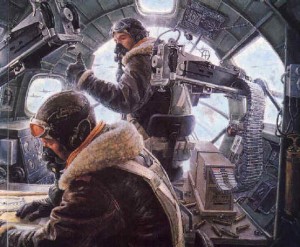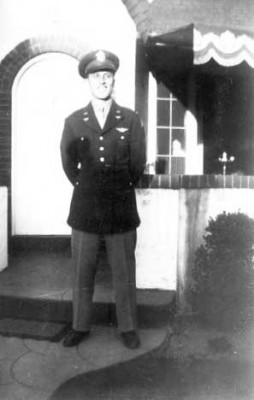04 Feb Dead Reckoning
When Herman finished his Bombardier Training at Victorville, his whole family came down from Washington State to watch him graduate. It was then, on May 8th, 1943, that Herman was commissioned as a 2nd Lieutenant and proudly received his wings. He was an officer!
He was next sent to Carlsbad, New Mexico … “The Battle of Carlsbad” as he called it in his scrapbook. A Spokane, Washington newspaper column titled “Axis Smashers” read: H.F. Allen Graduates from Carlsbad Air Field. “Unique among the schools of the Army Air Forces is the navigation school at the Carlsbad Army Air Field, Carlsbad, New Mexico. Included among the graduates was Second Lieutenant Herman F. Allen …
Lt. Allen recently received his bombardier wings upon graduation from the Victorville, California Bombardier School. All students at the Carlsbad school, the only one of its kind, are commissioned bombardiers who come to Carlsbad to receive a special intensified course in ‘dead reckoning’ navigation. With this additional training, they are able to direct a plane to its objective and also drop the bombs on the spot most beneficial to the United Nation’s war effort.”
It was important for a bombardier to be schooled in navigation so that in case of a crisis he could take over and perform this job or in case they had to fly with a nine-man crew.

Navigator and Bombardier
Excerpted from the Pilot Training Manual for the B-17 Flying Fortress (with additional assistance from Lt. Larry A. Jackson, B-17 navigator)
“The navigator’s job is to direct your flight from departure to destination and return. He must know the exact position of the airplane at all times. The Navigator determines the geographic positions by means of (a) pilotage – visual reference to the ground … railroad lines, rivers, for example. (b) dead reckoning – you used the wind direction (from a wind meter), air speed, ground speed, compass heading corrected for distortion of the plane and plotted your position on your map with continual up date. (c) radio – tuning into two or three stations and where the lines crossed was your position…not used very much, or (d) celestial navigation – “shooting the stars” … usually three stars and you were (hopefully) where the three lines crossed, corrected for the time lapse between first shot and last. This is when the navigator used his sextant, accurate time, and many tables to obtain a line of position. By any one or combination of methods the navigator determines the position of the airplane in relation to the earth.”
Yes, Daddy, I am very impressed at how complicated this was and how smart you airmen had to be. That little explanation doesn’t mention that the flak is flying everywhere and German fighters could be shooting from any angle while you’re in that B-17, freezing cold, on oxygen, trying to figure it out.
A teacher should be a guide, for even a map is sometimes wrong. ~Herman F. Allen, 1942
Update: There is a Facebook page dedicated to the old Carlsbad Army Air Field. See comment below.



Bobby Lee Silliman
Posted at 01:22h, 09 FebruaryHello,
I am contacting you here to let you know that there now exists a facebook page that is dedicated to the old Carlsbad Army Air Field. I am a co-moderator of this fairly new facebook page and I am thrilled to be able to share stories, photos and information about the CAAF. Please feel free to drop in and interact with all of us and upload snapshots or post stories for all to read. Occassionaly you will see a story or photograph of something that is not directly connected with the Carlsbad Army Air Field such as Roswell Army Air Field or Hobbs Field but they were closeby and contributed greatly to training Bombardiers, navigators and pilots during WW2.
Hoping that you will climb aboard this informative Facebook group and share your stories.
Best Regards
Bobby Lee Silliman
Pat
Posted at 09:24h, 09 FebruaryThank you so much, Bobby! I have “liked” your FB page. There is a lot of information there that will be helpful to me. I’ll try to find something to add. THANKS, Pat